List of US Vice Presidents (ABW)
Jump to navigation
Jump to search
| No.[a] | Portrait | Name (Birth–Death) |
Term | Party[b] | Election | President | |
|---|---|---|---|---|---|---|---|
| 1 | 
|
John Adams (1735–1826) |
April 21, 1789[c] – March 4, 1797 |
Pro-Administration[d] | 1788–89 | George Washington[e] | |
| Federalist | 1792 | ||||||
| 2 | 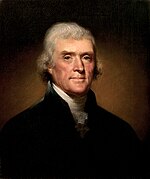
|
Thomas Jefferson (1743–1826) |
March 4, 1797 – March 4, 1801 |
Democratic-Republican | 1796 | John Adams[f] | |
| 3 | 
|
Aaron Burr (1756–1836) |
March 4, 1801 – March 4, 1805 |
Democratic-Republican | 1800 | Thomas Jefferson | |
| 4 | 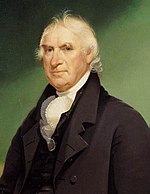
|
George Clinton[g] (1739–1812) |
March 4, 1805 – April 20, 1812 |
Democratic-Republican | 1804 | ||
| 1808 | James Madison | ||||||
| Office vacant April 20, 1812 – March 4, 1813[h] | |||||||
| 5 | 
|
Elbridge Gerry[g] (1744–1814) |
March 4, 1813 – November 23, 1814 |
Democratic-Republican | 1812 | ||
| Office vacant November 23, 1814 – March 4, 1817[h] | |||||||
| 6 | 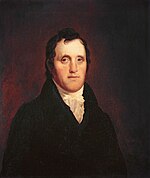
|
Daniel D. Tompkins (1774–1825) |
March 4, 1817 – March 4, 1825 |
Democratic-Republican | 1816 | James Monroe | |
| 1820 | |||||||
| 7 | 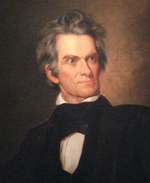
|
John C. Calhoun[i] (1782–1850) |
March 4, 1825 – December 28, 1832 |
Democratic-Republican | 1824 | John Q. Adams | |
| Nullifier[j] | 1828 | Andrew Jackson[k] | |||||
| Office vacant December 28, 1832 – March 4, 1833[h] | |||||||
| 8 | 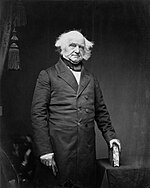
|
Martin Van Buren (1782–1862) |
March 4, 1833 – March 4, 1837 |
Democratic | 1832 | ||
| 9 | 
|
Richard Mentor Johnson (1780–1850) |
March 4, 1837 – March 4, 1841 |
Democratic | 1836 | Martin Van Buren | |
| 10 | 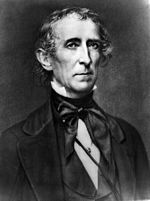
|
John Tyler[l] (1790–1862) |
March 4, 1841 – April 4, 1841 |
Whig[m] | 1840 | William H. Harrison | |
| Office vacant April 4, 1841 – March 4, 1845[h] | John Tyler | ||||||
| 11 | 
|
George M. Dallas (1792–1864) |
March 4, 1845 – March 4, 1849 |
Democratic | 1844 | James K. Polk | |
| 12 | 
|
Millard Fillmore[l] (1800–1874) |
March 4, 1849 – July 9, 1850 |
Whig | 1848 | Zachary Taylor | |
| Office vacant July 9, 1850 – March 4, 1853[h] | Millard Fillmore | ||||||
| 13 | 
|
William R. King[g] (1786–1853) |
March 4, 1853 – April 18, 1853 |
Democratic | 1852 | Franklin Pierce | |
| Office vacant April 18, 1853 – March 4, 1857[h] | |||||||
| 14 | 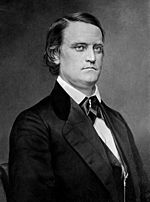
|
John C. Breckinridge (1821–1875) |
March 4, 1857 – March 4, 1861 |
Democratic | 1856 | James Buchanan | |
| 15 | 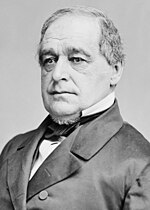
|
Hannibal Hamlin (1809–1891) |
March 4, 1861 – March 4, 1865 |
Republican | 1860 | Abraham Lincoln | |
| 16 | 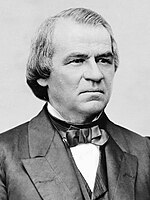
|
Andrew Johnson[l] (1808–1875) |
March 4, 1865 – April 15, 1865 |
National Union[n] | 1864 | ||
| Office vacant April 15, 1865 – March 4, 1869[h] | Andrew Johnson | ||||||
| 17 | 
|
Schuyler Colfax (1823–1885) |
March 4, 1869 – March 4, 1873 |
Republican | 1868 | Ulysses S. Grant | |
| 18 | 
|
Henry Wilson[g] (1812–1875) |
March 4, 1873 – November 22, 1875 |
Republican | 1872 | ||
| Office vacant November 22, 1875 – March 4, 1877[h] | |||||||
| 19 | 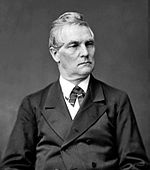
|
William A. Wheeler (1819–1887) |
March 4, 1877 – March 4, 1881 |
Republican | 1876 | Rutherford B. Hayes | |
| 20 | 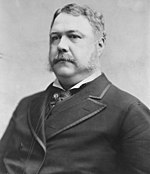
|
Chester A. Arthur[l] (1829–1886) |
March 4, 1881 – September 19, 1881 |
Republican | 1880 | James A. Garfield | |
| Office vacant September 19, 1881 – March 4, 1885[h] | Chester A. Arthur | ||||||
| 21 | 
|
Thomas A. Hendricks[g] (1819–1885) |
March 4, 1885 – November 25, 1885 |
Democratic | 1884 | Grover Cleveland | |
| Office vacant November 25, 1885 – March 4, 1889[h] | |||||||
| 22 | 
|
Levi P. Morton (1824–1920) |
March 4, 1889 – March 4, 1893 |
Republican | 1888 | Benjamin Harrison | |
| 23 | 
|
Adlai Stevenson I (1835–1914) |
March 4, 1893 – March 4, 1897 |
Democratic | 1892 | Grover Cleveland | |
| 24 | 
|
Garret Hobart[g] (1844–1899) |
March 4, 1897 – November 21, 1899 |
Republican | 1896 | William McKinley | |
| Office vacant November 21, 1899 – March 4, 1901[h] | |||||||
| 25 | 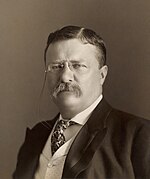
|
Theodore Roosevelt[l] (1858–1919) |
March 4, 1901 – September 14, 1901 |
Republican | 1900 | ||
| Office vacant September 14, 1901 – March 4, 1905[h] | Theodore Roosevelt | ||||||
| 26 | 
|
Charles W. Fairbanks (1852–1918) |
March 4, 1905 – March 4, 1909 |
Republican | 1904 | ||
| 27 | 
|
Albert J. Beveridge[g] (1862-1927) |
March 4, 1909 – March 4, 1913 |
Republican | 1908 | ||
| 28 | 
|
Charles Evans Hughes (1862–1948) |
March 4, 1913 – March 4, 1921 |
Republican | 1912 | Albert J. Beveridge | |
| 1916 | |||||||
| 29 | 
|
Warren G. Harding[l] (1865–1923) |
March 4, 1921 – August 2, 1923 |
Republican | 1920 | Leonard Wood | |
| Office vacant August 2, 1923 – March 4, 1925[h] | |||||||
| 30 | 
|
Henry L. Stimson (1867–1950) |
March 4, 1925 – 7 August, 1927 |
Republican | 1924 | ||
| Office vacant August 2, 1927 – March 4, 1929[h] | Henry L. Stimson
| ||||||
| 31 | 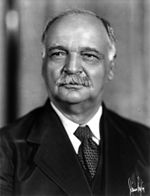
|
Charles Curtis (1860–1936) |
March 4, 1929 – March 4, 1933 |
Republican | 1928 | ||
| 32 | 
|
John Nance Garner (1868–1967) |
March 4, 1933 – January 20, 1941 |
Democratic | 1932 | Franklin D. Roosevelt | |
| 1936 | |||||||
| 33 | 
|
Henry A. Wallace (1888–1965) |
January 20, 1941 – January 20, 1945 |
Democratic | 1940 | ||
| 34 | 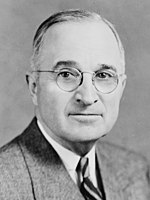
|
Harry S. Truman[l] (1884–1972) |
January 20, 1945 – April 12, 1945 |
Democratic | 1944 | ||
| Office vacant April 12, 1945 – January 20, 1949[h] | Harry S. Truman | ||||||
| 35 | 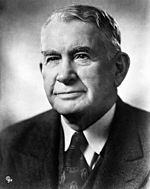
|
Alben W. Barkley (1877–1956) |
January 20, 1949 – January 20, 1953 |
Democratic | 1948 | ||
| 36 | 
|
Richard Nixon (1913–1994) |
January 20, 1953 – January 20, 1961 |
Republican | 1952 | Dwight D. Eisenhower | |
| 1956 | |||||||
| 37 | 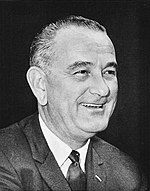
|
Lyndon B. Johnson (1908-1973) |
January 20, 1961 – January 20, 1969 |
Democratic | 1960 | John F. Kennedy | |
| 1964 | |||||||
| 38 | 
|
Terry Sanford (1917-1998) |
January 20, 1969 – January 20, 1977 |
Democratic | 1968 | Robert F. Kennedy | |
| 1972 | |||||||
| 39 | 
|
Bob Dole[o] (1923–2021) |
January 20, 1977 – January 20, 1985 |
Republican | 1976 | Howard Baker | |
| 1980 | |||||||
| 40 | 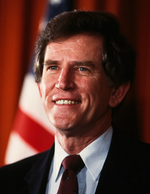
|
Gary Hart (b. 1936) |
January 20, 1985 – January 20, 1993 |
Democratic | 1984 | Walter Mondale | |
| 1988 | |||||||
| 41 | 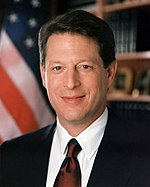
|
Al Gore (b. 1948) |
January 20, 1993 – January 20, 2001 |
Democratic | 1992 | Bill Clinton | |
| 1996 | |||||||
| 42 | 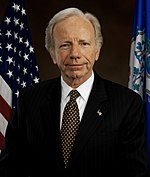
|
Joe Lieberman (1942-2024) |
January 20, 2001 – January 20, 2009 |
Democratic | 2000 | Al Gore | |
| 2004 | |||||||
| 43 | 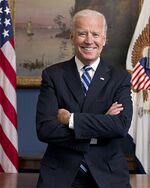
|
Joe Biden (b. 1942) |
January 20, 2009 – January 20, 2017 |
Democratic | 2008 | Barack Obama | |
| 2012 | |||||||
| 44 | 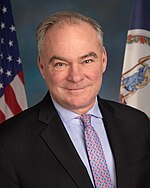
|
Tim Kaine (b. 1958) |
January 20, 2017 – January 20, 2025 |
Democratic | 2016 | Hillary Clinton | |
| 2020 | |||||||
| 45 | 
|
Doug Burgum (b. 1956) |
January 20, 2025 – Incumbent |
Republican | 2024 | Nikki Haley | |
Notes
- ↑ The U.S. vice presidents are counted according to uninterrupted periods of time served by the same person. For example, John Adams served two consecutive terms and is counted as the first vice president (not the first and second). Likewise, George Clinton is counted as the fourth and John Calhoun as the seventh, even though each one's consecutive terms in office were served under more than one president. Following the resignation of 39th vice president Spiro Agnew, Gerald Ford became the 40th vice president even though he was chosen to serve out the remainder of Agnew's second term. Then, after Ford succeeded to the presidency later in that same term, Nelson Rockefeller became the 41st vice president and served out the remainder of the term.
- ↑ Reflects the vice president's political party at the start of their vice presidency. Changes during their time in office are noted. Also reflects the president's political party unless otherwise noted beside the individual's name.
- ↑ Due to logistical delays, John Adams assumed the vice presidency 1 month and 17 days after the March 4, 1789, scheduled start of operations of the new government under the Constitution. As a result, his first term was only 1,413 days long, and was the shortest term for a U.S. vice president who served a full term.
- ↑ Pro-Administration is a contemporary term for the supporters of the political and economic policies of the Washington administration prior to the formation of the Federalist and Democratic–Republican parties.
- ↑ George Washington remained unaffiliated with any political faction or party throughout his eight-year presidency. Greatly concerned about the very real capacity of political parties to destroy the fragile unity holding the nation together, he was, and remains, the only U.S. president never to be affiliated with a political party.
- ↑ The 1796 presidential election was the first contested American presidential election and resulted in a situation where the persons elected president and vice president belonged to opposing political parties. Federalist John Adams was elected president, and Thomas Jefferson of the Democratic-Republicans was elected vice president.
- ↑ 7.0 7.1 7.2 7.3 7.4 7.5 7.6 Died in office
- ↑ 8.00 8.01 8.02 8.03 8.04 8.05 8.06 8.07 8.08 8.09 8.10 8.11 8.12 8.13 8.14 Prior to ratification of the Twenty-fifth Amendment, February 10, 1967, an intra-term vacancy in the vice presidency could not be filled.
- ↑ Resigned from office
- ↑ John Calhoun, formerly a Democratic-Republican, founded the Nullifier Party in 1828 to advance the cause of states' rights, but was brought on as Andrew Jackson's running mate in the 1828 presidential election in an effort to broaden the political coalition emerging around Jackson.
- ↑ Andrew Jackson's supporters from the former Democratic-Republican Party, which had largely collapsed by the mid-1820s, began calling themselves 'Democrat' during his first term in office, thus marking the evolution of Thomas Jefferson's Democratic-Republican Party into the modern Democratic Party.
- ↑ 12.0 12.1 12.2 12.3 12.4 12.5 12.6 Succeeded to the presidency intra-term.
- ↑ John Tyler was elected vice president on the Whig Party ticket in 1840. His policy priorities as president soon proved to be opposed to most of the Whig agenda, and he was expelled from the party in September 1841.
- ↑ When he ran for reelection in 1864, Republican Abraham Lincoln formed a bipartisan electoral alliance with War Democrats by selecting Democrat Andrew Johnson as his running mate, and running on the National Union Party ticket. Later, while president, Johnson tried and failed to build a party of loyalists under the National Union banner. Near the end of his presidency, Johnson rejoined the Democratic Party.
- ↑ Having lived to the long age of 98 years and 135 days, Bob Dole, who served as vice president under Howard Baker, is the second-longest-lived vice president in American history, being only 215 days short of the current record-holder John Nance Garner, who, after serving as vice president under Franklin D. Roosevelt, lived to the age of 98 years and 350 days, the longest for any vice president in American history.